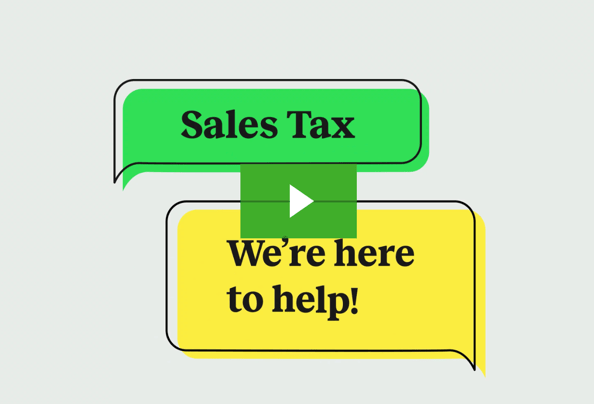After reading this guide, you’ll understand the basics of sales tax for Square merchants, and we’ll present you with the solution for all of your sales tax troubles.
And hey, if you’re busy and just want to cut to the chase, we hear you. Skip down to part 2 where we solve all of our sales tax problems with the TaxJar for Square app!
If you already know the basics and just want to cut to the chase, we hear you. Skip down to part 2 where we solve all of our sales tax problems with TaxJar!
Sales Tax 101 for Square Merchants
As a Square merchant, you want to understand every nuance of your business. Some aspects – like sales tax – can get overwhelming quickly.
If you fall into this camp, then this quick guide is for you. The goal is to explain the basics of sales tax for new eCommerce sellers (or seasoned eCommerce sellers who have questions.)
As a Square merchant, you must also understand how to configure your Square app to collect sales tax, all the while staying compliant with tax codes and giving your customers the fast, efficient checkout experience they’ve come to expect. TaxJar has your back on all of this.
The Basics of Sales Tax
Forty-five U.S. states and D.C. levy a sales tax. Merchants in these states are required to charge sales tax to buyers.
Sales tax is considered a “pass-through” tax, because the merchant is only holding the taxes collected before remitting it to state and local taxing authorities at a set time (usually either monthly, quarterly or annually.)
Sales tax is used to fund state projects and initiatives, including schools, roads, public safety departments, etc.
In the U.S., states have quite a bit of leeway with sales tax administration. Because of this, all 45 states (plus D.C.) that levy a sales tax have different rules and laws when it comes to sales tax. Sales tax rates can vary by state and locality, too.
One example of how state sales tax rules vary is that some states require you to charge sales tax on shipping charges, while others do not. Another example: some states might require you to renew your sales tax permit periodically, while others do not.
Even more confusing – some local areas may levy sales tax even in states with no statewide sales tax (such as in Alaska.)
It’s important to get in touch with your state’s taxing authority or an experienced accounting professional should you have questions about sales tax. Here’s a map with plenty of info about how to contact each state’s taxing authority.
Determining Sales Tax Nexus
All merchants must collect sales tax in states or localities where they have “sales tax nexus.”
While all states have a slightly different definition of this term, sales tax nexus is generally defined as “presence” in a state. This presence must be significant enough so that a business has to comply with the state’s sales tax law
Presence can include – but is not limited to – an office, economic activity in a state, an employee or a warehouse.
If you have sales tax nexus in a state that requires sales tax collection, then you’re required to collect sales tax from all buyers in that state regardless of where the item is shipped from.
If you do not have sales tax nexus in a state, then you’re not required to collect sales tax when you sell online to buyers in that state (regardless from where the item is shipped).

4 Common Examples of Sales Tax Nexus
1. Home state nexus – You live and run your eCommerce business in Texas. Because you have a physical presence in Texas, you have “sales tax nexus” there, and therefore are required to collect sales tax from buyers in the state of Texas.
2. Employee nexus – You live and run your eCommerce business in the state of Florida, but you hire your sister in Georgia to help you. Because you operate out of Florida and have an employee in Georgia, you now have sales tax nexus in Florida and Georgia and must collect sales tax from buyers in both states.
3. Economic nexus – “Economic nexus” is when a seller is required to collect sales tax in a state because they make either a certain dollar amount of sales in that state or have a certain number of sales transactions in that state. The most common economic nexus threshold in a state is $100,000 in sales or 200 transactions in a year. Economic nexus is a fairly new concept, and only about half the U.S. states with sales tax have economic nexus laws, though more states are adding new economic nexus laws and regulations. You can read about each state’s economic nexus laws here. And you can find out where your business has economic nexus by using TaxJar’s Sales & Transactions Checker.
4. Inventory nexus – Most states have ruled – either definitively or vaguely – that 3rd party fulfillment constitutes nexus. This means that if you store your inventory in a warehouse in a state, then that constitutes sales tax nexus. So if you live in Wisconsin, but store your inventory in California for the purposes of faster shipping, then you have sales tax nexus in both states.
Example #4 can be especially cumbersome for 3rd party sellers, whose inventory may be stored in states other than their home state. Third-party selling, and the associated sales tax registration and filings required, can create a huge administrative burden on unsuspecting eCommerce merchants.Once you’ve determined where you have sales tax nexus, you’re required to do two things:
1. Obtain a sales tax permit (sometimes called sales tax license) for that state (in the cases of third-party sellers this means acquire a license in every state where you warehouse inventory)
2. Begin collecting sales tax in that state (most states consider it illegal to collect sales tax without a permit)

Collecting Sales Tax from Buyers
Every eCommerce business owner wants their business to grow and thrive. Growth can’t be achieved if you have to manually calculate how much sales tax to collect every time you make a sale. That’s why most online sales platforms must include a sales tax component.
A note on sales tax rates: States set a rate, and then localities can add a percentage on top of those rates. For example, in the 90210 zip code, the tax rate is the 6.5% California statewide rate, a 1% Los Angeles County rate, and an additional 1.5% local rate, for a total of 9.0% sales tax rate.
Why did we have to put these guides together? Because, unfortunately, collecting sales tax via various online platforms is rarely simple. This is especially true if you collect sales tax at multiple rates, such as is the case for sellers in destination-based states. This is why TaxJar for Square sellers is so useful. To find out how, keep reading.We always caution that you check and double check the sales tax rates that you are charging your customers.
Origin-Based Sales Tax States and Destination-Based Sales Tax States
When it comes to determining tax rates, most states fall into one of two major buckets when it comes to sellers with home state nexus: “origin-based” sales tax states and “destination-based” sales tax states.
In layperson’s terms, this means that some states require you to collect sales tax at the rate effective at the point of “origin” (i.e. your office or warehouse) while most states require you to collect sales tax at the rate of the “destination” (your buyer’s address.)Keep in mind that the above only applies to your “home state.” Most states, with exceptions of California, Arizona and New Mexico, require out-of-state sellers to collect at the rate of the buyer’s ship to address.
Origin vs. Destination-Based Sales Tax Examples
Let’s say you live in (or have a warehouse or office in) Irving, Texas, but sell to someone in Archer City. Texas is an origin-based sales tax state, so you would charge any buyer in the state of Texas your home rate of 8.25%. (That’s Texas’s statewide 6.25% rate plus Irving County’s 1.0% plus a local Dallas MTA rate of 1.00%.) You don’t need to take your buyer’s address in Archer City into account.

But if you live in Stamford, New York the rules are different. Since New York is a destination-based sales tax state, you’re required to collect sales tax at the effective rate at your buyer’s address. So if you operate your business in Stamford and sell to a buyer in Buffalo, then you are required to charge the seller 8.75% sales tax – the total sales tax rate at their locality in Buffalo. (That’s a New York state base rate of 4.0% plus the Erie County rate of 4.75%).

For more information, see this map of Origin vs. Destination Sales Tax Collection in the United States.
We know that some online sellers also sell offline at brick and mortar stores, trade shows, craft fairs, etc. If you find yourself in a situation where you need to lookup a local sales tax rate, check out TaxJar’s Sales Tax Calculator as a quick reference.
Once you have determined your sales tax rate and collected sales tax from buyers, you then have to remit the funds you collected to your state(s). (Remember, sale tax is a passthrough tax and you don’t get to keep it!) Collecting the right amount of sales tax?
If you’re concerned that you haven’t collected the right amount of sales tax from buyers, TaxJar has a “Detailed Sales Tax Analysis” report that will help. We’ll search your channels and make sure you collected every penny of sales tax you were supposed to collect.
We also allow you to enter the date you first established sales tax nexus in a state. Users who begin using TaxJar in the middle of a taxable period will appreciate remitting every cent you owe to a state, but not a penny more.

See a problem? You can also click on each state on your TaxJar dashboard and see an “Expected Sales Tax Due” report. This report will show you how much we thought you should have collected in each state and taxing district (city, county, etc.) to help you figure out where the discrepancy lies.

Why is this so important? Sometimes your state can decide to perform a sales tax audit on your business. We’ve heard from many sellers that these audits are more arduous than IRS audits. This is just another reason why it’s so important to get a handle on sales tax early – before the state gets a handle on you!
Remitting Sales Tax to Nexus States
A state’s taxing authority is generally called the “[State] Department of Revenue” though it can go by other names. (For example, California’s taxing authority is the “California Department of Tax and Fee Administration.”)
When you apply for your sales tax permit with your state’s taxing authority, they will assign you a frequency at which to file and remit sales tax. This is generally monthly, quarterly or annually, and often depends on your sales volume or the volume of sales tax you collectMost states require that you file a sales tax report even if you do not owe sales tax. If you do not file, you could be subject to penalties. Pay close attention to instructions you receive your sales tax permit.
Sales Tax Filing Due Dates
Be warned that while many states set their sales tax due date as the 20th of the month, states can vary wildly in their sales tax due dates. If you are a quarterly payer, be sure you are aware of which date your state considers a “quarterly” due date. Sales tax filing due dates can vary to a surprising degree. You can check sales tax due dates in every state here.
How to File Sales Tax Returns
As with sales tax rules, every state has slightly different requirements for filing sales tax returns. For more details on how to file in each state refer to state sales tax info.
Most states allow you to file and pay online, and some even require it.
Be warned that some states are harsh taskmasters (usually ones that are destination-based for tax collection like Washington), and require you to report how much sales tax you collected in every single sales tax district. Some states have hundreds of sales tax districts, so this can easily turn into a nightmare – especially if you’re filing in multiple states at a time.
TaxJar has you covered here, too. After you connect your eCommerce accounts to TaxJar, we’ll subtotal your sales and sales tax collected by state, and country, city and special tax when it’s required. With TaxJar, you don’t have to deal with spreadsheets or sales tax tables to try and determine how much sales tax you collected from each jurisdiction.

TaxJar makes filing sales tax in destination-based states like Washington dead simple.
Summary of the Basics of Sales Tax for Square Merchants
To be sales tax compliant as an online seller you must:
- Determine where you have sales tax nexus.
- Register for a sales tax permit in each state where you have nexus.
- Set up your channels to collect the correct amount of sales tax from buyers.
- Periodically file sales tax for each state where you have sales tax nexus.
This process can be overwhelming for many online sellers. We built TaxJar to make reporting and filing your sales tax automatic. Sign up for a 30 day trial and stop worrying about sales tax forever.
How to Install the TaxJar Sales Tax Plugin from the Square App Store
Collecting is the easy part, pulling reports to accurately fill our your returns is another story.
Ready to get started automating your sales tax headaches? Connecting your Square account to TaxJar is dead simple. 1. From your Square Dashboard, click the “Apps” tab.” 2. Find TaxJar, then click “Get started”.
- From your Square Dashboard, click the “Apps” tab.”
- Find TaxJar, then click “Get started”

Read over the permission and click “Allow”

If you already have a TaxJar account, provide your username and password. If not, provide a password to sign up for a TaxJar account.

Once your Square and TaxJar accounts are connected, you’ll be asked to provide the address of your primary business location. We’ll use this address as your taxing jurisdiction by default.

On this page, you’ll also be asked how often you remit sales tax to the state where your primary business address is located

If you have already set up sales tax rates in your Square account to collect sales tax on transactions processed through Square, we’ll ask you to tell us where each of the sales tax rates are used so that TaxJar can identify which jurisdictions those transactions took place in

Congrats! Square and TaxJar are now working together in perfect harmony. TaxJar will now download your Square transactions every night.
Sales Tax Management for Square Merchants
Now for the nuts and bolts. How can you manage the hassle of sales tax with TaxJar?
Once you’ve connected your Square and TaxJar accounts, be on the lookout for an email from TaxJar. We’ll let you know which transactions imported and from which states.
Click on the state in that email to go to TaxJar and see more detailed information like:
- How much sales tax you collected
- Your gross sales for your sales tax filing period
- A breakdown of sales tax collected by county and district
From there you can use this information to fill out your own sales tax filing or click “AutoFile” and allow TaxJar to do it for you.
TaxJar also helps you troubleshoot sales tax compliance issues.
For example, your TaxJar dashboard shows you when no sales tax was collected. TaxJar’s “Detailed sales tax analysis report” will show you how much you SHOULD have collected vs. how much you did collect. You can use this information to determine whether you should pay that sales tax out of pocket to the state yourself.
This process can be overwhelming for many online sellers, we built TaxJar to make reporting and filing your sales tax automatic. Sign up for a 30 day trial and stop worrying about sales tax forever.



